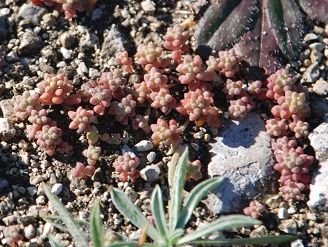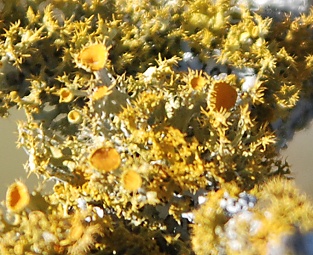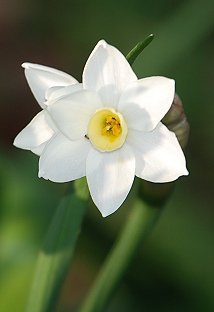Richard and Michael were up in the dry woods today to cut down our Christmas trees (we use Ashe junipers we’d want to get rid of anyway), and while they were looking for the right tree, they found a swarm of bees. I wasn’t able to go out right away to photograph them, and by the time I did get out, mid-late afternoon, the bees were very, very, very active. As in, those bees did not want anyone to come closer to where the swarm had been seen.
I’ve had bees (nice gentle Italian bees) and know that Africanized bees are in this county…so when a bee starts that “vrooom-vrooom” kind of humming/buzzing, I’m not inclined to argue with her. I went on up the trail to Fox Pavilion. The stonecrop is getting large enough to see; I love the delicate colors it has before its flowers open.

Unfortunately, I don’t know what the two forbs are growing at the bottom (green leaves) and top (purple leaves), but the stonecrop was quite pretty–and when it flowers this year, we’ll have a mass of yellow on the rock.
I couldn’t spend long looking for interesting things to photograph, because I had bread in the oven, so on the way back to the house I paused to look at the lichens and ball moss on a cedar elm. I may try to post the ball moss photo later, but here’s some bright yellow lichen with fruiting bodies like fringed orange goblets:

After the bread came out, I went into the back yard where the old white jonquils or daffodils (not really sure which) are still blooming under the ash tree. Last year they didn’t bloom at all because of the drought, but this year they started early:

Many stems have 3-5 flowers, not just one, but this is the clearest picture I got. Someone had planted these years and years ago along the driveway in front; I think Richard moved this clump to the back yard (but they may have just come up.)
Comment by Chuck — December 18, 2009 @ 10:56 pm
It’s hard to tell, but this looks like the white and yellow flowers my grandmother used to call “April White Narcissus” – except that the stems/leaves look like the same green as the all-yellow jonquils she grew/I grow (the April Whites have a darker green foliage). On the other hand, her narcissus sometimes have multiple blooms on one stem, but her jonquils never more than two, and mostly one. I think her April White must be what many people call Paper White Narcissus. The blooms are smaller than those of the jonquils, too (which are smaller than I think of daffodils being). Size seems to be the main attribute used in her distinction between the mostly white narcissus and the always yellow jonquils and daffodils. I don’t think she was familiar with the more exotic color variations in daffodils; I wasn’t until I started getting the Parks catalogs in the 1980’s.
Comment by elizabeth — December 18, 2009 @ 11:16 pm
Thanks, Chuck. Do you know if these can naturalize well away from houses? I know they’re not native, but I’d still like to have some down in the woods. (I think Richard planted some there, but they were immediately dug up and eaten. Many things we try to plant turn into critter-food.)
Comment by cdozo — December 19, 2009 @ 1:30 am
I agree those are probably Narcissus. We had them in Connecticut. My mom planted them under trees around our property and they did fine, but I’ve had trouble getting them to grow in Texas.
I love the lichen pictures. I thought they were sunflowers at first.
Comment by elizabeth — December 19, 2009 @ 9:13 am
I find lichens fascinating, but after buying myself a huge reference tome full of gorgeous pictures…I can’t figure ours out anyway. We have lots and lots…this yellow one is one of the commonest, but there’s another very like it except the “stems” are green, not yellow.
Comment by Chuck — December 20, 2009 @ 10:59 pm
The narcissus growing in my yard right now were bulbs from an old home site in Mississippi, plowed up as a field for planting soybeans. The house has been gone for at least sixty years, maybe longer — my grandfather was born in it in the 1890’s. My cousin and I found the bulbs lying in a furrow, uncovered by the plow, and I planted them in my yard in Bedford. Then I moved to Hurst, and dug them up and planted them again first in a flower bed, then in the yard, around the base of a mimosa tree. They spread more slowly in this setting than they do in a flower bed, but they’ve done okay.
It may be a little wetter here between Fort Worth and Dallas than it is where you live (aside from the drought you’ve been going through, I mean), but I think they’d have a good chance of naturalizing. They might not bloom the first year or two after moving. My grandmother’s rule for all these bulbs was to wait until the leaves turned yellow and died down before digging them — she said you could move them at other times, but they did best under those conditions.
Comment by elizabeth — December 21, 2009 @ 8:42 am
I love the thought that these flowers might be old-old ones transplanted from place to place by those who first moved to this town.
We are dryer than your area, I think, but I may try it anyway. “Wait until the leaves die back…” OK.
Comment by Chris — December 28, 2009 @ 12:08 pm
If it makes you feel any better, lichens are notoriously difficult to identify, even for botanists. There simply aren’t a lot of field guides for them, and I suspect that (like grasses) a good field guide would be difficult to write because species that look very similar may actually be very different under the microscope, and vice versa. The situation on field guides for mushrooms is a little better but not a whole lot.
(The older taxonomy of grasses above the genus level has now been pretty thoroughly scrambled — DNA analysis and other things not visible to the naked eye or hand lens have revealed a very different set of relationships than what was thought to be related based on flower placement and other easy-to-see features.)
Lichens, like other fungi, fall into a kind of no-person’s-land in classification. Really they are only “plants” by courtesy, because they have been traditionally studied by botanists. Biochemically, fungi are a completely separate kingdom, actually closer to animals than plants in some ways.
Comment by elizabeth — December 28, 2009 @ 12:57 pm
DNA analysis has really made a mess of traditional taxonomy, even in vertebrates. I just saw something in NATURE about the discovery that the “common skate” of the Atlantic is actually two species, and they aren’t even one another’s close relative.
Yeah, I know lichens are difficult, but I keep tackling the book and hoping for some resolution….we have a LOT of lichens on the place, what with multiple species of plants they grow on, plus the rocks. And I love knowing what things are…and “another yellow/gray/green/red/pink with spots/ lichen” isn’t enough for me. Same with fungi. I want to have a list of what’s on the place…everything I can find and identify. And yet, though I’m fairly well versed in botany, and am learning entomology as fast as I can, I just can’t get a handle–at all–on the fungi and the lichens. So I don’t feel at all guilty for not picking up lichen-stuff fast, but it’s still frustrating.
One useful thing (not yet in lichens but elsewhere in nature study) has been the rapid growth of online resources leading to state and county-level checklists (to some of which I’ve contributed.) Sites like Odonata Central and BAMA and BugGuide.net arefantastic resources for the novice. As these grow, it’s a lot easier for people entering at the novice level in one “area”–birds or dragonflies or beetles or trees–to look at what’s known to exist where they are, and look for the horses before tackling the zebras, as well as learning about that area of interest. And the more you look, the more you see. I spent considerable time in a very wet year photographing every lichen I could find and noting which grew on oaks, which on cedar elms, which on hackberries, etc. I had no idea there were that many, and I’m sure I missed some, simply through not having enough time. Yet except for being fairly sure that the gold tangles are some species of Teloschistes…I’m still at the level of “that pale green flat one with the little ivory spots that grows on live hackberry.”